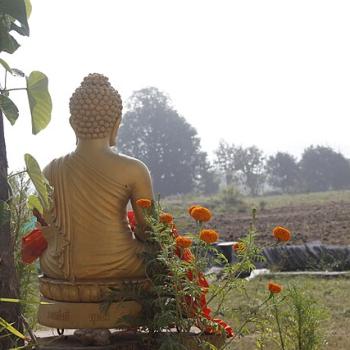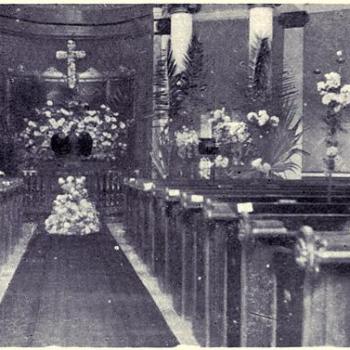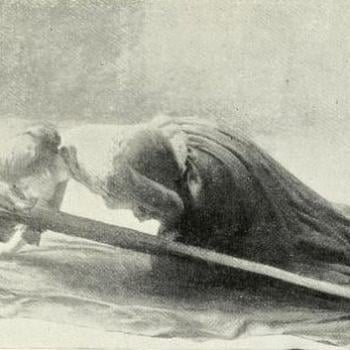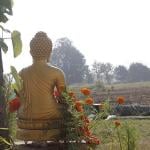THE DAY THE WORLD AWAKENED
The Buddha’s Enlightenment, and Ours
James Myoun Ford
8 December 2008
Benevolent Street Zen Sangha
Providence, Rhode Island
Today is the eighth day of the twelfth month, generally marked in the Buddhist world as the anniversary of the moment Gautama Siddhartha, Shakyamuni, the sage of the Shakyas, watched the morning star rise in the sky and came to his great realization.
In the Zen tradition, at least within the Japanese inheritance, this is called Rohatsu. Rohatsu is generally marked with intensive meditation retreats, called, again, after the Japanese style “sesshin,” meaning to touch the heart mind. Often on this day participants on retreat sit in zazen for the entire night. Something I recall from my youth, but not a practice I’ve indulged myself in some years.
Our Boundless Way communities gather for a Rohatsu retreat on the second weekend of December, a compromise with the facts of our lives as people living ordinary lives in the West. But whether precisely at this time, or a few days later, on a retreat, an all night sit, an evening gathering, or just a few moments captured on the fly, recalling this day and its story is an important invitation.
Zen has a genealogical quality about it, that is the teachers stand in a direct line of authority that mythically goes all the way back to the Buddha, himself. Historically, it actually goes a fair way back through the generations, if not quite all the way to the historic Buddha. Out of this sense of transmission, of family, there is a literary tradition called “lamp anthologies,” stories of awakening and the passing of the lamp.
At the beginning of the fourteenth century the master Keizan Jokin, fourth ancestor from Eihei Dogen, founder of the Soto school in Japan, and a teacher in one of our Boundless Way’s direct lineages, and mine, particularly, compiled a lamp anthology as a koan collection. It is preserved as a practice document within the Harada Yasutani lineage, which is the koan style we teach.
Over at Wild Fox Zen, you can get most of the story as transmitted by Keizan. For the purposes of koan introspection two parts are extracted from Keizan’s accounts and given particular attention. The first is called the “case.” There are various translations, the one I’m using here is our in-house text, first translated by Koun Yamada and Robert Aitken, and later modified by John Tarrant and Joan Sutherland.
Shakyamuni Buddha, seeing the morning star, gained enlightenment and said, “I and all sentient beings of the great earth have in the same moment attained the way.”
And Keizan’s appreciation verse becomes another point of focus.
One branch from the old plum tree extends splendidly forth. Thorns become attached to it in time.
Keizan’s anthology is placed near the end of formal koan practice in our style, which I think wise. It is a subtle document. On first glance to the maturing practitioner it seems to be pretty much the same case repeated fifty-two times. Perhaps appropriately, we are, after all each of us catching the same flame. Our individual human experience is that common human experience, in some very real sense one thing. And each of us on this way is finding how our own individual blossoming comes from our common ground, our native earth.
The Indian stories are more dream like, more magical, in part reflecting their purely mythical aspects. Zen, after all, wouldn’t birth in India, but a millennia after the Buddha, in the rich soil of China. And even the stories of the first five Chinese ancestors are themselves a blending of myth with flesh and blood, befitting their more or less historical quality. After that, the remaining cases begin to have a more complete smell of human struggle, failure, and victory.
I like all these kinds of stories. But, there is something about those stories that mark the turning of the wheel, the dawn of new insight, the renewal of our human possibility in a new age. There are three of these, stories that particularly point to the shaping of the Zen way. This one recounting the Buddha’s awakening, the story of Bodhidharma coming from India to China, and the story of Huineng, the great sixth ancestor of the Chinese transmission.
The history of each of these stories is subsumed to other purposes. And those purposes are the establishment of this school, the way of awakening that we follow in this gathering.
History has a place. I think it very important to learn our history. But, as a matter of koan practice, of that assertion about reality and invitation to our own intimate encounter, we don’t need to worry a whole lot about the history of any of these events. And we won’t be spending any more time reflecting on where these stories come from and how closely they relate to what we know about historic figures that are the actors in these various dramas.
Here is the invitation within these stories. In fact, they’re about you. They’re about me. They’re about what we can find, when we throw caution to the wind, open our hearts and minds wide, and allow the universe to present itself as it is. After ages of hard practice,
Siddhartha once a prince, and now just one more homeless vagabond, after sitting quietly through the night, watching, listening, just being present: he looks up and sees the morning star. And in that seeing everything is revealed.
This encounter is not limited to the Zen world. William Blake gives us much the same sense of this foundational story, of Siddhartha looking up to the morning star, and noticing something fundamental about who and what we are. He could have used Blake’s words.
To see a World in a Grain of Sand And a heaven in a Wild Flower, Hold Infinity in the palm of your hand And Eternity in an hour.
Although I feel the more direct expression unmodified by all those “a’s” which litter Blake’s little verse, which we get out of twenty-five hundred years of distillation, of reflection on this encounter, gives it a bit more directly. While in our practice we take Shakyamuni’s statement “I and all sentient beings of the great earth have in the same moment attained the way.” as one point, I suggest we can profitably break this into four points for this evening. Some are stated, some implied. Let me reframe it slightly, as befits the various translations and versions, distilled as “At this moment I see that I, all beings, and indeed the great earth itself, awaken together.
At this moment.
I see.
That I, all beings, indeed the great earth itself.
Awaken together.
First, about “this moment.” Within our tradition we are constantly called back to this moment. Of course we stray, all the time. To the past, regrets and triumphs. Or, we run to the future with its longing and anxieties. This morning I attended a Christian funeral. The priest spoke of past present and future, and the complexities of these moments in time. But her thrust was to the future, to the heavenly time. This is not how we approach the matter. While the past and the future have numinous elements that invade this moment, our invitation is to not stray overly to the past or to the future, but rather come here; this is home.
Next, and so important is that “I.” As in Gestalt’s therapy we are invited to play all the characters, all the parts, in any koan. Each becomes intimate, each part, me. No second person, no third. What is to be found is going to be found in you, in you, in you. Each as me, as I, as I, as I.
And that bleeds into that other clause, “that I, all beings, indeed the great earth itself.” Here each thing arises in its own way. I. All beings. The great earth. Each thing distinct, following its own trajectory in time and space. But that clarity has begun to fog. We’ve taken on the various parts, each as an I. And no doubt as we venture deeply into the great matter, things become confused. Deep into this we find that “I” which inhabits this body, is also the many other “I’s” that manifest as all beings. And then we find it is also the “I” that is the earth, itself. The question presents itself. Is there any place that isn’t I?
Here, perhaps we capture a bit of the sense of the Rastafarian term “I and I.” But, let’s not push that too far. We tumble at this moment into something very dream like, very confusing. But the guidance of our teachers is to let it play, to let these contradictory experiences each wash over us. As Blake sings.
He who binds to himself a joy Does the winged life destroy. But he who kisses the joy as it flies Lives in eternity’s sun rise.
And that brings us to the great victory, to that line “awaken together.” How can we not awaken together? We are made of the same stuff, you and I and the great earth. We are, each of us, an expression of something other. That “I” is, along the way, first completely lost and then, miraculously, regained, but as something new, something subtely different. As one contemporary teacher put it, echoing older lines of older masters, “Before awakening I drank beer and hung out with my friends, after awakening I drink beer and hang out with my friends.”
This journey of exploration and finding takes us to a place of incredible intimacy, where you and I are you and I and yet, at bottom, each and every one of us, is also vast as the sky, completely boundless. The German poet. Ranier Maria Rilke saw this, and sang of it, in Stephen Mitchell’s translation.
Ah, not to be cut off, not through the slightest partition shut out from the law of the stars. The inner – what is it? if not intensified sky, hurled through with birds and deep with the winds of homecoming.
But maybe this isn’t completely clear. So, Keizan composes a verse in celebration of this matter. The first line goes “One branch from the old plum tree extends splendidly forth.” Now the direction is different. That I is no longer the center of the universe. We, you and I, we each of us are now branches, coming forth from the old plum tree, from the great source.
And then “thorns become attached to it in time.” This isn’t a reminder of forgetting, although that’s a spiritual question for another time; rather it is a celebration of our true individuality, completely grounded in that vastness which we all share, but at the same time, yours, mine, each thorn earned, each thorn glorious.
And all that, that’s what we celebrate today in sitting together, in reflecting on one person’s awakening, and in doing so, about our awakening, about our homecoming.
Any questions?













